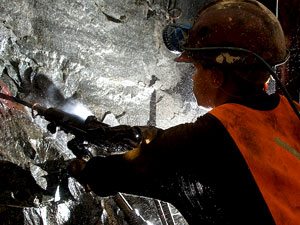
THE surprisingly large decline in mining production in March partly reflects low commodity prices but also indicates that South Africa’s mining industry is winding down more rapidly than imagined, commentators say.
Mining production in South Africa slumped 18% year-on-year in March, according to figures from Statistics South Africa. Worst hit were Platinum Group Metals (PGMs), which declined by 23.7%, manganese ore (-24.3%) and iron ore (-21.4%). Coal production dropped 15.8% and gold production was 7.4% lower.
Investec Securities said the drop in PGM production was “concerning” owing to the lack of a stronger market reaction given the steep drop in output.
“Part of the drop in output we understand is attributable to a closure at Amplats refinery and Implats 14 Shaft,” it said adding that Amplats was expected to catch up and therefore implying PGM prices may retreat again.
Cadiz Corporate Solutions’ mining director Peter Major said the commodities with the biggest production decreases were ‘coincidentally’ – those whose prices fell dramatically in 2015 to hit 10-year price lows last year.
He said the production decline in PGMs was “huge” and while the decline reflects the effect of public holidays and a platinum price under pressure, the official figures, indicating a loss of a quarter of production, were inexplicable.
One of the biggest problems, he said, was that mines had increasingly limited control over costs including electricity, labour costs and increasingly elaborate and stringent legislative costs.
The biggest factors affecting production at present are metal prices, followed by cutbacks, official and unofficial go slows, Section 54 and 55 safety stoppages and strikes, Major said.
There were a lot of cutbacks and retrenchments during last year, which have flowed through to affect production, and an seemingly increasing number of safety stoppages have really started to affect production.
Major said the production figures, while affected by public holidays in March, also represent a worryingly general winding down of much of SA’s mining industry. A lot of the production decreases are not going to be cyclical, he said. While there are still cyclical trends, the general direction is huge cause for concern.
In the late 1990’s – most world commodities hit 100 year low prices and yet SA was ‘growing’ production in most of them. That is obviously history now and unlikely to ever be repeated again.
Econometrix director and chief economist Azar Jammine said he expected weak figures due to the public holidays which were not similarly configured last year. “That would have had a huge impact in depressing year-on-year figures.”
In some respects this is a blip, and April production should be quite a bit better, he said. “Having said that, if we look at the preceding three months, production has been weak.”
The magnitude of the decline was exceptional, he said, but over and above that there is a weakness which is some cause for concern.
This reflects depressed commodity prices and mining companies curtailing output but may also reflect that the industry is fraught and mining businesses are winding down.
The mining production decline, which compares with a revised 8.3% decline in February, was significantly worse than economists’ expectations.
Seasonally adjusted production dropped 3.4% compared with February, and over the first quarter of 2016, seasonally adjusted mining production dropped 5.2% compared with the previous quarter.
Mineral sales increased marginally (by 1.6% year-on-year) in February, with the biggest increase being gold. Iron ore sales, however, were down by 31.5%.
Seasonally adjusted mineral sales at current prices increased 4.1% in February compared with the previous month.
Production figures are the worst South Africa has seen in at least a decade and a half, according to Bloomberg.










